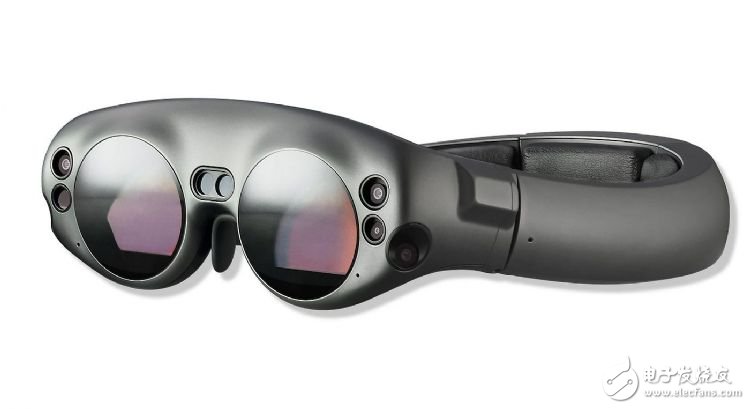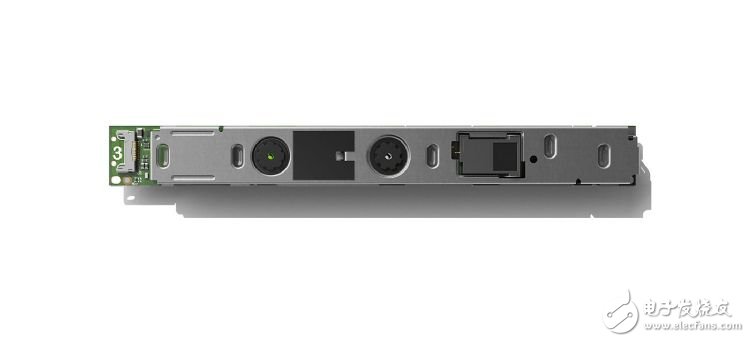AR/VR application into the industry to attract gold focus on the future market prospects are not predictable
In 2017, the investment issues and the amount of AR related to VR are amazing. The total investment in the second half of 2017 is 2.1 billion US dollars. Not only the previous majority investment, but also the VR application, AR related application investment is also actively catching up, AR/VR Application has become the most eye-catching focus of the IT industry...

Magic Leap One is the first AR eyewear product to be designed as a lens-based AR technology solution. The actual results are worth looking forward to. Magic Leap

The AR/VR boom triggered peripheral business opportunities and became a photographic sensing module that can detect the depth of the stereo space. Intel
The application and development of AR (Augmented Reality) and VR (Virtual Reality) has become the hottest IT issue in the near future. Not only is the investment/financing amount of related technologies and hardware amazing, but the value of peripheral audio-visual entertainment applications derived from it is also actively concerned by the industry. From the most forward-looking AR/VR underlying technology and patents, to various wearable computing or display devices for AR/VR applications, to the most terminal multimedia, video games, audio and video products, etc., the commercial value of the entire industry chain is huge, no wonder Investors will rush to invest large sums of money in future technologies.
AR/VR product experience is differentBefore examining the AR/VR industry, we should first understand the key differences between the two. AR is augmented reality, that is, superimposed digital information in real-life images. As for VR, it is a virtual reality constructed by full-virtualization. The biggest difference is AR application. The glasses are transparent, and the virtual environment can be seen in the real environment. As for the VR glasses, the VR glasses are opaque, and the virtual display is generated by the small display and the optical lens, so that the user is like the experience in the virtual environment.
Magic Leap and HoloLens are representative products of Augmented Reality glasses; representative products of Virtual Reality glasses such as Samsung's Gear VR, Google Cardboard or Oculus Rift.
Why are there AR glasses products? In fact, AR technology is an inevitable trend in the development of the IT industry. Since the development of smart phones, users have to operate through small screens. Users also need to carry electronic devices at any time. The key to the convenience of application is to overcome the human-computer interaction interface. Convenience, such as the iPhone product is only to optimize the touch screen operation human-computer interaction experience, which has created the scale of the current Apple smartphone market, and the AR technology solution can extend the user operation experience to the screen size instead of the screen size. In a truly visual environment, the benefits of technology introduction will be great.
AR technology has achieved concrete results.The existing AR glasses products have made great technological breakthroughs. If the products can be miniaturized to a portable state in the future, and the screen can be used as a screen space in front of the user's eyes, real-time rendering of the realistic 3D character animation into the visual real environment, although This concept of AR glasses products does not completely replace smartphone applications, but at least its entertainment, education or commercial applications have great potential.
Compared with VR technology, AR will find that the application scenario of AR will be more yuan, because VR technology will focus on the immersive virtual environment experience, VR glasses are basically opaque full cover covering the human eye, and use small screen to transmit optical As a virtual space image, the device size will be slightly larger than that of the AR glasses, and the convenience of carrying the application is slightly reduced.
Another argument may focus on more forward-looking Hologram technology, but in fact Hologram projection technology is still relatively early for commercial applications. The use of naked-eye Hologram display in outdoor environments is not effective and must be matched with special The built environment can be realized, the use of elasticity and commercial value is not easy to achieve, on the contrary, the value of small and portable AR glasses is highlighted.
VR/AR applications are no longer distinct.As for the VR/AR difference mentioned earlier, in fact, the use of technical integration is no longer so clear. For example, if VR glasses set up a camera at the front end of the device, the real vision of the user front end can also bring into the VR experience. Naturally, it can also achieve the imaging effect like AR glasses. This method is also partially designed in AR products. This kind of scheme is constructed by video see-through or video overlay video overlay, which is used in some common smart devices. App applications are also quite common. For example, Pokemon Go and AR Constellation Star Search software also have similar technical solutions.
However, in fact, the actual and virtual images are superimposed, and the technical solution will be much cheaper and less technically difficult than the transparent lens and the virtual imaging AR solution. Some software applications mostly use such technologies, especially in AR games. The AR education software application is quite common, but the AR image that is superimposed by superimposed virtual and captured images is actually very different from the AR solution presented by the transparent lens.
Because the AR image generated by the superposition is still a 2D flat screen presentation, the user is difficult to have a stunning experience, and the virtual stereoscopic imaging generated by superimposing in the real visual space space is presented as a fictional image of the real space, and the visual impact feeling is very different.
Pursuing immersive quality image processing performance is the key to the productFurthermore, if the image is captured by the camera, the system superimposes the virtual image synthesis, and the real/virtual integration experience like AR is presented in real time with VR glasses or devices, there is still a huge gap between the imaging experience of the transparent AR and the imaging experience. If the quality is to be simulated, the video resolution of the acquisition must be improved. In order to experience the dynamic feeling of real-time, the delay of collecting pictures, synthesizing pictures and rendering process must be overcome by using more powerful computing power and data processing capability. The product may sacrifice a large part of the real-life experience due to the cost of equipment parts, which is why the lens version of the AR technology solution is the most popular item among many existing solutions.
Take Magic Leap's AR glasses as an example. In fact, the related technologies used in imaging devices are quite diverse. For example, the light field display technology of Magic Leap One is specially made in the glass material through the light of the virtual image. A light field effect with depth of field is simulated through a photonic light field chip, allowing the user to more naturally focus on a virtual image near or far away. The advantage is that the size of the head-mounted AR display device can be made thinner, and the special glass lens solution can not only project 2D images, but the manufacturer claims to be able to construct a Light Field effect.
In the implementation of 3D scenes, there will be Stereoscopic and Light Field solutions. For example, Microsoft HoloLens and Facebook Oculus use Stereoscopic technology solution. Magic Leap uses Light Field concept instead of market-related technology. A solution that people expect.
Light Field technology is difficult but future market value is highTo understand the difference between Stereoscopic and Light Field, the main difference between 3D image and 2D image is the difference in depth. It creates a similar depth of field effect through two sets of 2D fine-tuning optical differences, which is the rendering of most 3D movies. The technical concept, but this Stereoscopic 3D will also bring another kind of trouble, such as the dizziness problem can be easily caused when the adjustment is not good. The light field 3D imaging scheme is different. The biggest difference from Stereoscopic 3D is that the light field can focus on different distances, forming a more natural law that conforms to the human eye. It is also called true 3D (true-3D) display. Program.
However, it is not easy to construct a light field display. Currently, there are two technologies: space mulTIplexing and time multiplex (TIme mulTIplexing). Space mulTIplexing uses pixels as several blocks to achieve different focus distance states. However, the problem will cause the rendered screen resolution to be affected. Time multiplexing is the use of high-speed components to quickly produce different focus distance effects, deceiving the naked eye to think that it is generated at the same time. The advantage of time multiplexing is to provide relatively good stereoscopic visual effects without loss of resolution.
Although the transparent lens type AR has a sense of space and experience, it will be a solution for many devices to sell in the market. However, transparent AR glasses still face many technical challenges. First, the technical problems in display, to achieve near-eye The light field display itself is quite difficult.
At present, in addition to Magic Leap's product application light field solution, market-related AR glasses/VR glasses products are mainly based on Stereoscopic 3D technology solutions, but even if Magic Leap claims to import light field technology, it must be in product size, light The field sampling technology/quality, the coordination of binocular wear and the like meet the commercialization requirements. At the same time, the transparent lens type AR products can meet the requirements of the uniform use effect of outdoor wear, which have a considerable degree of technical difficulty.
More importantly, the lens material and processing technology of the transparent lens type AR product is also a big cost problem. For example, Google Glass's AR solution is processed by using a spectroscope, but the spectroscope has a certain thickness and has the effect of a spectroscope. The thinning lens technology is complicated and costly. Commercialization still has a long way to go. In addition, there are problems such as field of view (FoV), resolution, image occlusion (Occlusion), and screen delay.
Ningbo Autrends International Trade Co.,Ltd. , https://www.ecigarettevapepods.com